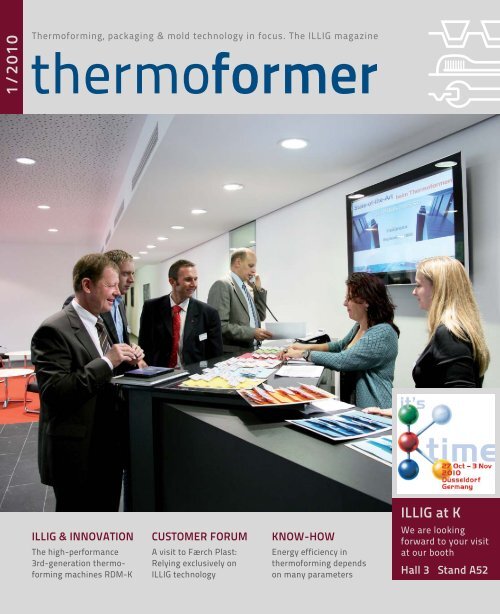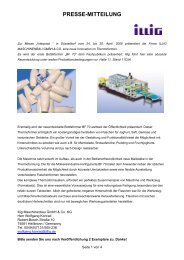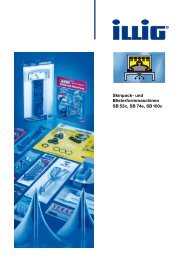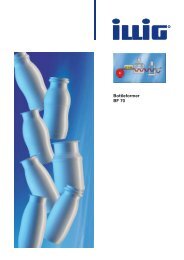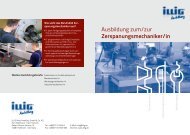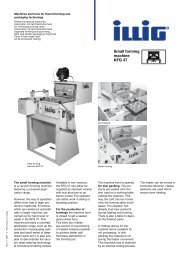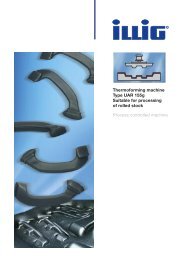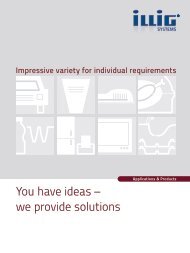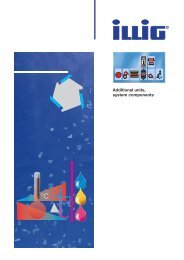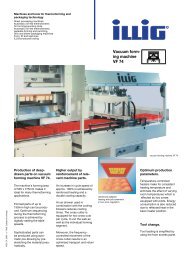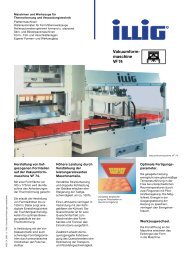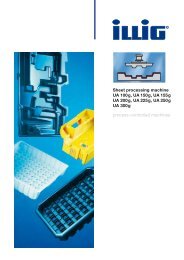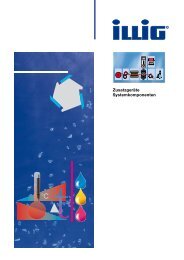Thermoforming - ILLIG Maschinenbau GmbH & Co. KG
Thermoforming - ILLIG Maschinenbau GmbH & Co. KG
Thermoforming - ILLIG Maschinenbau GmbH & Co. KG
You also want an ePaper? Increase the reach of your titles
YUMPU automatically turns print PDFs into web optimized ePapers that Google loves.
1/2010<br />
<strong>Thermoforming</strong>, packaging & mold technology in focus. The <strong>ILLIG</strong> magazine<br />
thermoformer<br />
<strong>ILLIG</strong> at K<br />
<strong>ILLIG</strong> & INNOVATION<br />
The high-performance<br />
3rd-generation thermoforming<br />
machines RDM-K<br />
CUSTOMER FORUM<br />
A visit to Færch Plast:<br />
Relying exclusively on<br />
<strong>ILLIG</strong> technology<br />
KNOW-HOW<br />
Energy efficiency in<br />
thermoforming depends<br />
on many parameters<br />
We are looking<br />
forward to your visit<br />
at our booth<br />
Hall 3 Stand A52
EDITORIAL IN THIS ISSUE<br />
3 <strong>ILLIG</strong> UPDATE<br />
After the crisis – looking ahead to K 2010<br />
4 <strong>ILLIG</strong> AT K 2010<br />
Tuned to high performance –<br />
Welcome in Hall 3, Stand A52<br />
7 <strong>ILLIG</strong> & INNOVATION<br />
3rd generation RDM-K now complete:<br />
Cup thermoforming re-specified<br />
Dear Thermoformers,<br />
We are pleased to present the first issue of our new magazine,<br />
thermoformer, to you today. As of now, we will keep you regularly<br />
updated on the most recent innovations in thermoforming on<br />
these pages. All over the world, this technology has established<br />
itself as a key manufacturing route for diverse products which play<br />
an indispensable role in many areas of our lives.<br />
New developments and applications of this technology, as well<br />
as its implementation by our customers, will therefore be in the<br />
focus of our reporting. In addition, we shall be examining practicerelated<br />
examples to give our readers fresh ideas and insights into<br />
the current state of our industry. Energy-efficiency, a sparing use of<br />
resources, new thermoplastic materials and methods of processing<br />
them – such are the issues we are looking at very hard and which<br />
therefore define current engineering trends in thermoforming.<br />
Moreover, as new applications emerge, we are faced with continuously<br />
more exacting demands. Machine and mold availability<br />
rates and the quality of thermoformed products are becoming<br />
ever more important. At <strong>ILLIG</strong>, ongoing product development is<br />
the strategy of choice for prevailing in this environment. Advanced<br />
motor and control technologies and optimized MMI solutions can<br />
deliver significant performance and efficiency gains today. For our<br />
customers to benefit from such advances in their day-to-day operations,<br />
highly skilled and motivated personnel is a key prerequisite.<br />
Dedicated operator training programs are therefore part of our service<br />
offering to enable users to actively design the change process.<br />
By providing extensive information we intend to help build a<br />
common discussion platform aimed at the continuous improvement<br />
and refinement of thermoforming technology. Our new magazine,<br />
thermoformer, seeks to lay the foundation for this exchange.<br />
We are looking forward to your suggestions, comments and requests<br />
which we will be glad to take up as input for our work.<br />
Yours faithfully,<br />
Karl Schäuble, Managing Director<br />
9 NEWS FROM MOLDMAKING<br />
The 3rd generation RDM-K molds:<br />
High dynamics and product uniformity<br />
at one stroke<br />
10 CUSTOMER FORUM<br />
A visit to Færch Plast:<br />
Food packaging made in Denmark<br />
14 KNOW-HOW FOR THERMOFORMERS<br />
Energy efficiency – how can it<br />
be compared?<br />
15 EXPERTISE UP TO DATE<br />
New <strong>ILLIG</strong> training concept –<br />
Geared to the practical needs<br />
of its target group<br />
16 NEWS IN BRIEF / CALENDAR<br />
COVER PAGE<br />
Entrance hall of the new <strong>ILLIG</strong><br />
Customer Center: Arrival of attendees<br />
at the 10th <strong>ILLIG</strong> Open House<br />
thermoformer<br />
Publisher: <strong>ILLIG</strong> <strong>Maschinenbau</strong> <strong>GmbH</strong> & <strong>Co</strong>. <strong>KG</strong><br />
Robert-Bosch-Straße 10, D-74081 Heilbronn – www.illig.de<br />
Editors: Wolfgang Konrad (responsible),<br />
wofgang.konrad@illig.de, Phone: +49 7131 505-236,<br />
Dr. Georg Krassowski (Konsens)<br />
Layout: Konsens PR <strong>GmbH</strong> & <strong>Co</strong>. <strong>KG</strong>,<br />
D-64823 Groß-Umstadt – www.konsens.de<br />
thermoformer is the custmer magazine from <strong>ILLIG</strong>,<br />
published regularly in German and English.<br />
Reprinting of articles after agreement with the editors and<br />
with indication of source permitted.<br />
2 thermoformer 1/2010
<strong>ILLIG</strong> UPDATE<br />
After the crisis – looking ahead to K 2010<br />
The impact of the gravest economic<br />
and financial crisis since the war has<br />
been weighing heavily on the mechanical<br />
engineering and industrial equipment<br />
manufacturing industry. However,<br />
with the encouraging uptrend in overall<br />
economic activity observed in the last few<br />
months, some of the blackest clouds on the<br />
economic horizon have dispelled and business<br />
has regained confidence.<br />
While producers of thermoforming machinery,<br />
molds and packaging equipment<br />
were hit with hitherto unknown severity<br />
by the crisis, at <strong>ILLIG</strong>, we never doubted for<br />
one moment that our customers, markets<br />
and products would regain their strength<br />
once it had passed. True to that conviction,<br />
we kept staff levels stable and bridged<br />
periods of excess capacity by encouraging<br />
personnel to deplete their flexitime accounts<br />
while introducing short-time work<br />
schemes.<br />
At the same time, our company continued<br />
with its personnel training programs,<br />
optimized production and assembly workflows,<br />
refined products and further stabilized<br />
quality levels. The successful outcome<br />
of these efforts will be presented at the “K”<br />
trade fair in Düsseldorf this October. A preview<br />
is given in this issue of thermoformer.<br />
<strong>Thermoforming</strong> – on track for success<br />
New-generation machines delivering increased<br />
performance, new energy-saving<br />
features and advanced process capabilities<br />
are providing thermoformers with highly<br />
efficient manufacturing resources today.<br />
In conjunction with <strong>ILLIG</strong>’s radically new<br />
ThermoLine<strong>Co</strong>ntrol system, tangible gains<br />
in productivity and cost efficiency can thus<br />
be achieved, particularly for production lines<br />
and integrated equipment environments.<br />
The successful IML technology initially<br />
launched for thermoforming round cups<br />
is currently being adapted to applications<br />
involving non-round packaging articles as<br />
well. This development is on the verge of<br />
completion.<br />
For users to benefit fully from our machines’<br />
improved performance, optimized<br />
The new <strong>ILLIG</strong> Customer Center –<br />
in use since the fall of 2009<br />
The new building erected at the Heilbronn<br />
plant has given <strong>ILLIG</strong>’s headquarters site<br />
a new architectural face. It comprises over<br />
1,800 sq.m. of useful floorspace, including<br />
more than 700 sq.m. for the new Customer<br />
Center which features a large conference<br />
hall with the latest communication and<br />
IT technology on the first floor plus several<br />
ground-floor multifunctional meeting<br />
rooms. The new building complex provides<br />
the requisite modern, forward-looking infrastructure<br />
for a living communications center<br />
dedicated to the sharing of expertise on all<br />
aspects of thermoforming. Here, projects<br />
will be developed and seen through to the<br />
implementation stage in joint enterprise<br />
with customers from all over the world. At<br />
the same time, the building will serve as the<br />
venue for our training programs dealing with<br />
the theory and practice of thermoforming.<br />
These courses have become regular events<br />
at Heilbronn and enjoy unbroken demand.<br />
stacking and discharge technology must be<br />
in place and increasingly rapid processes<br />
must be effectively visualized to the operator.<br />
Suitable optimization aids for running<br />
in new molds, a compensation for ambient<br />
factors in day-to-day service and the ability<br />
to save entire recipes to memory enable<br />
users to produce moldings of unvaryingly<br />
high quality.<br />
And for the first time ever, <strong>ILLIG</strong>’s<br />
ThermoLine<strong>Co</strong>ntrol system allows all peripheral<br />
equipment to be operated, controlled<br />
and monitored integrally along with<br />
the thermoforming machine. An assist<br />
system guides the operator through each<br />
mold change, thereby saving valuable setup<br />
time and yielding further plant availability<br />
gains.<br />
<strong>Co</strong>mmunication with a capital ‘C’<br />
For <strong>ILLIG</strong>, attendance at “K” - our industry’s<br />
key trade fair – is a matter of course since<br />
it gives us the opportunity to present the<br />
state of the art in thermoforming to a wide<br />
audience including, first and foremost, customers<br />
from all over the world.<br />
The intense market interest in this<br />
technology was already very much in evidence<br />
during our 10th Open House held at<br />
Heilbronn in late September 2009, an occasion<br />
which also marked the inauguration of<br />
our newly erected <strong>ILLIG</strong> Customer Center.<br />
More than half of the over 300 experts<br />
attracted by this event came from abroad,<br />
mostly from West and East European<br />
markets. However, customers from North<br />
and South America, the Asian region and<br />
China also came to Heilbronn to take an<br />
up-close look at the most recent trends in<br />
thermoforming.<br />
You, too, are cordially invited to visit<br />
us at Heilbronn for inspiration and to find<br />
out about the sheer diversity of thermoforming<br />
technology. At our new Customer<br />
Center we shall be glad to explain about<br />
application-specific solutions to your molding<br />
needs and to present our tailor-made<br />
operator training programs as well as the<br />
maintenance capabilities of our worldwide<br />
after-sales organization.<br />
thermoformer 1/2010 3
<strong>ILLIG</strong> AT K 2010<br />
Tuned for high performance<br />
Welcome in Hall 3, Stand A52<br />
The most recent technologies and ‘system<br />
solution’ benefits for high-volume<br />
thermoforming of plastic packaging<br />
articles in any shape and size are in the<br />
focus at the <strong>ILLIG</strong> booth at this year’s<br />
Real-life exhibits<br />
The equipment demonstrations staged at<br />
the <strong>ILLIG</strong> booth reflect real-life manufacturing<br />
scenarios. On an RDK 90 automatic<br />
pressure forming unit, the largest model in<br />
the line-up designed for a 900 mm processable<br />
stock width and 700 mm format feed<br />
length, APET trays (of the kind sold millions<br />
of times over as sales and keep-fresh packaging<br />
for food) are produced in a 16-cavity<br />
mold at a rate of 55 cycles/minute. Also<br />
from APET stock, an RDM 70K automatic<br />
thermoformer (molding surface area: 680 x<br />
300 mm²) makes yogurt cups in a 27-cavity<br />
mold.<br />
Reliable handling of these high product<br />
volumes – more than 50,000 trays and<br />
close to 70,000 yogurt cups per hour – is<br />
ensured by appropriate downstream equipment.<br />
The RDK 90 line includes a dual handling<br />
system which takes care of product<br />
removal and stacking. The stacker of the<br />
RDM-K line has a new turning head capable<br />
“K” fair in Düsseldorf. Two current<br />
3rd-generation roll-fed thermoforming<br />
lines based on RDK and RDM-K type<br />
machines and mold technology are to<br />
be demonstrated under production<br />
conditions. The RDK line of automatic<br />
pressure forming machines, providing<br />
combined thermoforming and punching<br />
action, is aimed at applications<br />
ranging from the production of hinged<br />
packs to menu trays and closure caps.<br />
RDM-K Series machines are employed<br />
mainly for thermoforming cups of any<br />
shape and size in multi-cavity molds.<br />
<strong>Co</strong>mpared to the previous standard,<br />
the cycle speeds of today’s systems<br />
have been raised by a factor extending<br />
well into the two-digit percent range.<br />
At the same time, molding quality is<br />
improved while the required energy input<br />
has been reduced. This also applies<br />
to the UA Series of sheet processing<br />
machines, the efficiency of which will<br />
of rotating through 180 degrees. Designed<br />
for up to 45 cycles/minute, the demolded<br />
cups can thus cool down for an entire cycle<br />
before being safely stacked.<br />
Servomotor-actuated throughout<br />
The consistent use of servomotors for all<br />
thermoformer operating sequences is key<br />
to the high cycle rates attained. These<br />
energy-saving high-speed motors provide<br />
elevated accuracy levels and permit a maximum<br />
of overlap between operating steps,<br />
thanks to their high positioning precision<br />
and repeatability. Thus, valuable process<br />
time is saved over each sequence. Another<br />
key factor contributing to the muchenhanced<br />
productivity of these machines<br />
compared to the previous generation is<br />
their outstanding dynamics in building up<br />
and releasing the forming air pressure. In<br />
the case of the RDM-K series, this has been<br />
achieved essentially by reducing the mold<br />
air volume by up to 70% on the new 3rd<br />
likewise be impressively demonstrated<br />
4 by <strong>ILLIG</strong> at the “K” fair.<br />
thermoformer 1/2010
generation molds. It has thus become possible<br />
to raise cycle rates by over 30%, and<br />
sometimes much more (for more details on<br />
the performance of the current RDM-K<br />
series, refer to page 7 and the following<br />
pages).<br />
Significantly enhanced productivity<br />
The effect of superior sequence overlap and<br />
the resulting process time gains on the productivity<br />
of the current process-controlled<br />
RDK/RDKP automatic pressure formers is<br />
illustrated in Table 2 for machines with existing<br />
(2nd generation) mold technology. By<br />
way of example, the comparison is shown<br />
for three different products. Similar productivity<br />
gains have been consistently obtained<br />
with customer tooling in may other applications.<br />
In most cases the increase amounted<br />
to well over 30%. One boundary condition<br />
set for the development of the new machines<br />
was that existing molds had to remain<br />
useable in unchanged form.<br />
Apart from increased productivity, the<br />
higher cycle rates had other beneficial effects<br />
as well. For one thing, the stock<br />
heated to the thermoforming temperature<br />
is molded at an earlier point in time, i.e.,<br />
while still in a more plastic state – and with<br />
a much more dynamic build-up of forming<br />
pressure. This makes for better contour<br />
definition in the mold cavity and hence, increased<br />
product quality. In fact, this effect<br />
might even be utilized to reduce the stock<br />
temperature with existing molds while<br />
maintaining the product quality unchanged<br />
and still benefiting from faster cycles.<br />
In order to make full use of the potential<br />
of its 3rd generation RDK and RDKP<br />
thermoformers, <strong>ILLIG</strong> has also improved<br />
the mold technology, and particularly mold<br />
cooling. One outstanding feature is the new<br />
jacket cooling system (cf. Fig. 1). <strong>Co</strong>mpared<br />
to conventional solutions, it enlarges the<br />
surface area available for heat transfer between<br />
the molding and the coolant inside<br />
the mold. The new jacket cooling system is<br />
particularly beneficial in molding semi-crystalline<br />
materials such as polypropylene.<br />
Fig. 1: High-performance line with RDK 90 automatic pressure forming machines. The moldchange<br />
system facilitates rapid format and mold changes (as with the 16-cavity tray mold<br />
shown) while the new jacket cooling system (bottom left) provides high molding quality and short<br />
cycles through its large-area, contour-following cooling action.<br />
Product<br />
L x W x H<br />
[mm]<br />
Hinged pack<br />
500 x 250 x 30<br />
Meat tray<br />
226 x 180 x 60<br />
Meat tray<br />
230 x 137 x 22<br />
Material<br />
thickness<br />
[mm]<br />
APET<br />
0.26<br />
PP<br />
0.65<br />
PP<br />
0.40<br />
2nd Generation<br />
Cycles / min<br />
3rd Generation<br />
Increase [%]<br />
28 (RDKP) 51 (RDKP) 82<br />
18 (RDK) 25(RDK) 39<br />
25 (RDK) 40 (RDK) 60<br />
Productivity comparison: Molds designed and operated by customers on 2nd generation thermoformers<br />
were tested in unchanged form on 3rd generation machines by <strong>ILLIG</strong>.<br />
Fig. 2: ThermoLine<strong>Co</strong>ntrol – Eliminates traditional paper documentation and the associated errors<br />
once and for all. The integrated data record management system supports a full argument-based<br />
search among all data for selective retrieval and rapid input upon re-launching production.<br />
New control technology:<br />
<strong>ILLIG</strong> ThermoLine<strong>Co</strong>ntrol<br />
Developed initially for the large RDK 90<br />
model, the new “<strong>ILLIG</strong> ThermoLine<strong>Co</strong>ntrol“<br />
system is now available for all roll-fed thermoformers<br />
including the RDM 70K demonthermoformer<br />
1/2010 5
strated in a cup molding application at the<br />
“K” fair. As a necessary condition for such<br />
universality, all add-on equipment and options<br />
– from the roll stand to the standalone<br />
cooling unit – come with a matching<br />
interface as standard.<br />
For the operator, ThermoLine<strong>Co</strong>ntrol<br />
provides a broad range of auxiliary functions,<br />
beginning with a basic start-up setting<br />
for each new product or mold. Once the<br />
material type, stock thickness and a few<br />
product and mold data have been entered,<br />
the program will automatically determine<br />
a basic setting – including a cycle rate and<br />
matching stock heating program. The<br />
machine is then ready for production, with<br />
all settings geared for optimum product<br />
quality.<br />
Fast retrieval and activation –<br />
productivity restored in no time<br />
The control system not only provides a continuous<br />
supervision and graphic visualization<br />
of the machine’s operating sequences<br />
but also saves all settings and process<br />
parameters to memory. Thus, the laborious<br />
manual documentation routines practiced<br />
for so long become a thing of the past. For<br />
all molds ever used and all products made<br />
to date on a given thermoformer, parameters<br />
can be stored in the new data record<br />
and recipe management system which provides<br />
search options for easy retrieval so<br />
that all data can be instantly used in production<br />
(Fig. 2).<br />
Beyond these thermoformer control<br />
features, the new <strong>ILLIG</strong> ThermoLine<strong>Co</strong>ntrol<br />
system conceived specifically for full-scale<br />
production lines provides several additional<br />
efficiency-enhancing benefits. As demonstrated<br />
on the RDK-90 line at the “K” fair, all<br />
operations of the individual machines making<br />
up the production line can be centrally<br />
managed, optimized and process-controlled<br />
via the MMI station on the thermoformer<br />
(Fig. 3). This capability will save much time<br />
during format or mold changes, apart from<br />
providing enhanced operator convenience.<br />
Given the additional advantage of the thermoformer’s<br />
mold quick-change system,<br />
formerly non-productive periods are thus<br />
converted into precious value-adding time<br />
(Fig. 4).<br />
Moreover, the new ThermoLine<strong>Co</strong>ntrol<br />
system makes fault analysis and troubleshooting<br />
tasks easier, faster and, above all,<br />
more focused. These advantages will be<br />
appreciated especially when a production<br />
line is remotely monitored via the Internet<br />
using <strong>ILLIG</strong>’s Net Service.<br />
RDK<br />
AWK<br />
VHW<br />
Fig. 3: ThermoLine<strong>Co</strong>ntrol – All machines and components in the line, such as the roll stand (AWK)<br />
and roll preheating system (VHW), are accessible and programmable at the central molding station<br />
(RDK), e.g., in the event of a format or mold change.<br />
Dramatically improved<br />
energy efficiency<br />
The actuation of all thermoformer movements<br />
by servomotors not merely translates<br />
into superior efficiency but also improves<br />
the equipment’s energy balance.<br />
Thus, depending on the machine type and<br />
drive system, up to 20% of the total power<br />
input can be saved by recovering braking<br />
energy.<br />
For all that, there are clearly more sides<br />
to a thermoformer’s energy efficiency. The<br />
latter is further influenced, e.g., by the type<br />
and use of the infrared heaters pre-heating<br />
the material, the power demand of the<br />
temperature control devices, and – quite a<br />
critical energy factor on roll-fed machines<br />
– the power required to provide the forming<br />
air.<br />
<strong>Co</strong>mparative measurements have<br />
shown that today’s much more powerful<br />
3rd generation thermoformers save up to<br />
50% power over older-generation <strong>ILLIG</strong> machines.<br />
The underlying causes and effects<br />
will be clearly illustrated on practical examples<br />
at <strong>ILLIG</strong>’s booth at the “K” fair (see also<br />
the article on page 14).<br />
> All further details will be<br />
presented at the <strong>ILLIG</strong> booth,<br />
Stand A52 in Hall 3<br />
Fig. 4: Rapid return to productivity – The conventional set-up process (left) is reduced to a minimum<br />
of steps with <strong>ILLIG</strong>’s new ThermoLine<strong>Co</strong>ntrol (right).<br />
6 thermoformer 1/2010
<strong>ILLIG</strong> & INNOVATION<br />
3rd generation RDM-K line-up is now complete<br />
Cup thermoforming re-specified<br />
With the recent completion of its<br />
RDM 75K automatic pressure forming<br />
machine (see cover photo), <strong>ILLIG</strong> now offers<br />
a full 3rd generation line-up of these<br />
versatile units. The fourth design size<br />
in the series achieves up to 42 cycles/<br />
minute in idle mode – a staggering 30%<br />
increase over its predecessor model. At<br />
the same time, the current equipment<br />
generation raises product quality to an<br />
unprecedented level in thermoforming.<br />
In developing its new range of RDM-K automatic<br />
pressure thermoformers employed<br />
chiefly in cup-making applications, <strong>ILLIG</strong><br />
had set itself two overriding goals. The 3rd<br />
generation machines should provide higher<br />
outputs while delivering improved product<br />
quality at the same time. While there was<br />
not much to be changed about the thermoforming<br />
principle in general, an analysis of<br />
past practices neverthless revealed scope<br />
for process improvement in the forming air<br />
application step.<br />
With the current machine and mold<br />
generation, forming air is supplied to each<br />
cavity directly via the respective prestretcher<br />
(refer to the article on p. 9). This<br />
technology ensures a controlled repeatability<br />
between cycles, which in turn has a<br />
direct effect on the uniformity of cups made<br />
in multi-cavity molds.<br />
Increased dynamics for shorter cycles<br />
Another innovation resulting in both increased<br />
molding quality and shorter cycle<br />
times lies in the reduced forming air volume<br />
used for molding each cup. <strong>Co</strong>mpared to<br />
the prior state of technology, 3rd generation<br />
RDM-K molds now need 50 to 70% less<br />
Fig. 1: Without downholder pressure level<br />
control, bead formation along the upper cup<br />
rim is inevitable (1). – The excess material<br />
(“bead deposit”) can be shifted by varying the<br />
clamping pressure (2). – Optimum adaptation<br />
of downholder pressure levels ultimately<br />
translates into a uniform wall thickness<br />
distribution (3).<br />
forming air per cavity. As a result, the<br />
forming pressure will build up at a much<br />
steeper rate (p. 9), which not only makes for<br />
much faster molding but also gives a substantially<br />
improved contour definition to<br />
the product.<br />
The time gains obtained by reducing<br />
the forming air volume, in conjunction with<br />
the new individual-cavity control process,<br />
can be exploited directly by the operator<br />
to increase the cycle rate. This productivity<br />
enhancement is supported by a new, optimized<br />
mold cooling system (p. 9).<br />
Uniform wall thickness<br />
The performance of these machines in<br />
terms of quality and productivity also<br />
benefits from another innovative solution,<br />
i.e., the downholder pressure level control<br />
system which adapts the force applied<br />
according to the specific thermoforming<br />
process stage (see p. 9). Until now, applying<br />
the full clamping force had invariably<br />
resulted in the formation of a permanent<br />
bead along the top edge of the cup (cf.<br />
Case 1 in Fig. 1).<br />
Systematic investigations revealed that<br />
this bead deposit, which accounts for approx.<br />
10% of the molded article weight, can<br />
be “shifted” by varying the downholder<br />
pressure (Case 2). With the new pressure<br />
thermoformer 1/2010 7
Product<br />
Jogurt cup, PS<br />
73 mm dia., 1.25 mm wall thickness<br />
Drink cup, PS<br />
73 mm dia., 0.8 mm wall thickness<br />
Jogurt cup, PS<br />
75 mm dia., 1.15 mm wall thickness<br />
Drink cup, PP<br />
75 mm dia., 1.2 mm wall thickness<br />
2nd Generation<br />
level control system, the downholder force<br />
is matched perfectly to the time curve of<br />
the thermoforming process, so that the<br />
undesirable material deposit is drawn<br />
completely into the side wall as the cup is<br />
formed. The result is a highly uniform wall<br />
thickness distribution (Case 1 in Fig. 1).<br />
Moreover, the “additional” material<br />
thus drawn into the side wall gives added<br />
strength to the cup, i.e., the top load rating<br />
is increased. <strong>Co</strong>nversely, a thinner web material<br />
(10% less basis weight) would suffice<br />
to produce a molding of the same strength.<br />
This corresponds to a direct reduction in<br />
material costs.<br />
Cycles /min<br />
3rd Generation<br />
Increase [%]<br />
22 36 63<br />
25 37 48<br />
28 36 28<br />
28 36 28<br />
Numerous innovations on the 3rd generation RDM-K automatic pressure forming machines<br />
(exemplified by an RDM 70K with a 24-cavity mold in this case) have yielded marked productivity<br />
gains (increased cycle rate).<br />
Tangible increase in product quality<br />
and productivity<br />
<strong>Co</strong>mpared to the previous series, these<br />
3rd generation automatic pressure forming<br />
machines consistently achieve around<br />
30% shorter operating cycles in drink cup<br />
thermoforming service, depending on the<br />
material type and shape of the cup. In some<br />
cases, much higher gains are achieved (cf.<br />
Table). The same applies to product quality<br />
parameters.<br />
For economic reasons, cup walls are<br />
kept as thin as possible (reduced material<br />
cost) while on the other hand, the thermoformed<br />
product is expected to withstand<br />
a certain minimum top load. In the case of<br />
Fig. 2: One notable feature of the new stacker is the turning head system which now supports<br />
rotation through 180 degrees. Its “two-sided” operability allows aftercooling of products after removal<br />
from the mold (left) for an entire cycle before they are put down in the stacker cage (right).<br />
a yogurt cup, for instance, which must be<br />
securely sealed after filling, the flatness of<br />
the sealing rim becomes crucial over and<br />
beyond the given thickness of the material.<br />
A maximum rim angle variation of 5 deg. is<br />
not to be exceeded since the cup will otherwise<br />
not be positively sealable in a volume<br />
production line.<br />
The RDM-K automatic pressure forming<br />
machines and 3rd generation mold<br />
technology remain far below the tolerance<br />
limits specified for the above criteria. Notwithstanding<br />
the major increase in cycle<br />
speeds achieved, the cups are consistently<br />
less susceptible to rim angle deviations –<br />
even when measured across all cavities of a<br />
multi-cavity mold.<br />
Process reliability in stacking<br />
In order to cope reliably with the enhanced<br />
output of the new thermoformers, stacker<br />
technology has been advanced as well<br />
(Fig. 3). Even short, bulging cups which are<br />
difficult to keep properly aligned are reliably<br />
transferred to downstream equipment in<br />
unattended operation, whether for packing<br />
counted cup stacks into a transport container<br />
or for direct filling, sealing and packing<br />
on integrated lines.<br />
All stacker components are made of<br />
wear-resistant materials throughout.<br />
<strong>Co</strong>ntamination of the cups with foreign particles<br />
– as can never be fully avoided, e.g.,<br />
with stacking cages comprising brushes,<br />
rubber or similar stack holder materials – is<br />
thus prevented. Freedom from contamination<br />
is an important criterion not only if the<br />
cups are to be subsequently filled with food<br />
products.<br />
The high precision and repeatability of<br />
3rd generation RDM-K automatic pressure<br />
forming machines also becomes evident<br />
when they are started up in production. As<br />
soon as the mold has reached operating<br />
temperature the first true-to-specification<br />
cups emerge, ready to be stacked. The new<br />
RDM-K generation is suitable both for offline<br />
roll-fed operation and for in-line use<br />
downstream of a flat-film extruder. The<br />
standard range comprises four machine<br />
sizes addressing various requirements in<br />
industrial practice, with the RDM 54K (mold<br />
surface area: 520 x 300 mm²), RDM 70K (680<br />
x 280 mm²) and RDM 78K (760 x 420 mm²)<br />
having now been joined by the most recent<br />
RDM 75K (735 x 465 mm²) model.<br />
8 thermoformer 1/2010
NEWS FROM MOLDMAKING<br />
The 3rd generation of RDM-K molds<br />
High dynamics and product uniformity at one stroke<br />
Synchronous pressure<br />
build-up – in all cavities<br />
Second-generation RDM-K molds reflect<br />
the state of the art of their time, with central<br />
valves handling the supply of forming<br />
air to all cavities. In the development of 3rd<br />
generation thermoformers, lateral valves –<br />
integrated into the mold – were used as a<br />
first step. Each of these valves controlled<br />
the supply of forming pressure to one<br />
single row of cavities. Although this method<br />
already constituted an improvement over<br />
the prior-generation, an absolutely synchronous<br />
airflow to the cavities could not<br />
yet be ensured in this manner. The task of<br />
forcing the material into conformance with<br />
the cavity contours and pressing it against<br />
the cooled mold wall (thereby initiating<br />
cooling) was completed within a given<br />
inter-cavity “time window”, resulting in<br />
non-uniform product characteristics.<br />
In the current 3rd generation molds,<br />
forming air is separately supplied to each<br />
cavity directly via the pre-stretcher (Fig. 1).<br />
<strong>Co</strong>mpressed air is thus gated directly into<br />
each cavity. To this end, a solenoid valve<br />
assigned to each cavity is fitted in the upper<br />
mold part for a defined, synchronous<br />
build-up of forming air pressure.<br />
The synchronous admission of forming<br />
air is all the more important in view of<br />
the severely reduced forming air input per<br />
cavity which is achieved through improved<br />
design (see p. 7). Even with this diminished<br />
air demand, a dynamic (steep) build-up<br />
and release of forming air pressure (Fig. 2)<br />
occurring simultaneously in all cup-forming<br />
cavities can thus be ensured.<br />
Advanced mold technology contributes<br />
in a major way to the high productivity<br />
and product quality attained by the 3rd<br />
generation RDM-K automatic pressure<br />
forming machines.<br />
Forming air<br />
Fig. 1: Each cavity now has its own solenoid<br />
valve for a controlled, precise and repeatable<br />
supply of forming air.<br />
Forming pressure [bar]<br />
3<br />
2<br />
1<br />
B<br />
0<br />
1 3 5 7 9 11 13 15 17 19 21<br />
Time [ms]<br />
A<br />
Solenoid valve<br />
Time gained<br />
Fig. 2: <strong>Co</strong>mpared to the prior standard<br />
(Case A), the reduction in forming air volume<br />
(Case B) results in a significantly more<br />
dynamic build-up and release of forming air<br />
pressure. The associated time gains can be<br />
used to run higher cycle rates.<br />
<strong>Co</strong>ntrolled pressure profile<br />
On 2nd generation molds, the full downholder<br />
force was commonly applied upon<br />
closing of the mold. This practice invariably<br />
resulted in the formation of a bead along<br />
the upper cup rim, as described in detail on<br />
page 7. However, in terms of process technology,<br />
the maximum downholder force is<br />
needed only during application of the full<br />
forming air pressure. During pre-stretching<br />
of the material and punching of the<br />
molded product the downholder force may<br />
be lower.<br />
With the new pressure level control<br />
system, the downholder contract pressure<br />
is adapted to the specific phase of the<br />
thermoforming process. The full downholder<br />
force is not exercised until the main<br />
forming air pressure sets in; it is then<br />
reduced toward the end of the molding<br />
cycle (Fig. 3). Another innovation is that<br />
that the downholders are cooled directly<br />
to support short cycle times.<br />
Optimized mold cooling<br />
The mold now comprises up to four cooling<br />
circuits. Individually controllable, these supply<br />
coolant separately to the upper mold<br />
part, the downholders, the lower mold part<br />
and the ejectors. In order to accelerate the<br />
dissipation of heat from the cavities, the<br />
molds have contour-following cooling<br />
passages of adequately sized crosssection.<br />
It is not necessary to reduce the coolant<br />
temperature – quite the opposite is true.<br />
While previously the coolant had to be<br />
at 12 °C, the new molds can be cooled with<br />
water in the 16 …18 °C range. This saves<br />
energy but also reduces the risk of moisture<br />
condensation in the mold, which is<br />
always extant at elevated air humidity<br />
levels.<br />
Pressure<br />
1 3<br />
Time<br />
1: Pre-cooling 2: <strong>Co</strong>oling 3: Punching<br />
Fig. 3: The clamping pressure of the cooled<br />
downholders is applied in stages matching<br />
the process to avoid bead formation along the<br />
upper cup rim. At the same time, the shorter<br />
application of the full pressure benefits mold<br />
and machine life.<br />
2<br />
thermoformer 1/2010 9
CUSTOMER FORUM<br />
A visit to Færch Plast, Holstebro/Denmark<br />
Food packaging<br />
made in Denmark<br />
“Danish Food Packaging“ by Færch Plast<br />
has become a brand name with reputation<br />
extending far beyond Denmark. With over<br />
500 office and production staff employed<br />
today at its headquarters site in Holstebro,<br />
sales offices in England and France and a<br />
manufacturing facility in the Czech Republic,<br />
the company produces high-grade food<br />
packaging systems – and puts faith in <strong>ILLIG</strong><br />
thermoforming equipment.<br />
10 thermoformer 1/2010
PS CPET APET PP PLA<br />
Food is a valuable product. Protecting<br />
it along the value-adding chain from<br />
the producer to the retailer and on<br />
to the consumer, thus allowing it to be<br />
brought to the table fresh and appetizing,<br />
is the stated ambition of Færch Plast A/S<br />
(www.faerchplast.com), the Danish packaging<br />
specialist. The company is headquartered<br />
at Holstebro, a town of<br />
34,000 situated in picturesque<br />
north-western Jutland,<br />
close to the North Sea<br />
and the Limfjord – the<br />
long stretch of water<br />
which links the<br />
North Sea to the<br />
west with the Kattegat<br />
in the east<br />
and has been dividing<br />
Vendsyssel-Thy, Denmark’s<br />
second largest island, from<br />
southern Jutland since the<br />
flood of 1825.<br />
Since its formation in 1969,<br />
Færch Plast has built a name for itself<br />
as a leading developer and manufacturer<br />
of high-quality food packaging. Working<br />
around the clock, the company produces<br />
plastic packaging for diverse applications<br />
by thermoforming. The bulk of its products<br />
consists of trays of different shape, color<br />
and functionality for primary ready meals<br />
and fresh meat, but also for salads, snacks<br />
and other cold food products. These trays<br />
are made of sheets consisting of polyethylene<br />
terephthalate (PET) – more specifically,<br />
semi-crystalline CPET and amorphous<br />
APET – even polypropylene (PP), polystyrene<br />
(PS) and even polylactic acid (PLA), a<br />
so-called biopolymer.<br />
The company supplies its products to<br />
the food processing and retail industry,<br />
with<br />
exports –<br />
destined mainly<br />
for the entire European market – accounting<br />
for around 80% of its output.<br />
Attractive jobs – ambitious<br />
corporate policy<br />
A job with Færch Plast is considered highly<br />
attractive employment in the region. “To<br />
us, our employees are our most important<br />
resource. With their skills and commitment,<br />
they are key to our ability to keep on<br />
increasing our competitiveness and to remain<br />
on a constant growth path”, acknowledges<br />
Lars Gade Hansen, the company’s<br />
managing director.<br />
As a manufacturer catering to the foodstuffs<br />
industry, Færch Plast has always<br />
been convinced that its foodstuff packaging<br />
should meet the same high hygiene standard<br />
as the food itself. Thus, specific headgear<br />
or protective clothing must be worn in<br />
all production areas, depending on the individual<br />
job activity. All production employees<br />
are issued fresh work wear every day.<br />
Similarly, production technologies<br />
and processes at Færch Plast have been<br />
required to comply with hygiene, product<br />
safety and quality standards from the<br />
start. Thanks to this approach, the company<br />
quickly won hygiene certification by<br />
ADAS, the British research and consulting<br />
organization, in 1998. Today its certification<br />
conforms to the internationally recognized<br />
BRC/IoP standard developed by the British<br />
Retail <strong>Co</strong>nsortium (BRC) and the Institute of<br />
Packaging (IoP).<br />
Environmental and energy management<br />
are likewise key themes in the company’s<br />
policy. “In 1996, at the request of the<br />
public authorities, we started to measure<br />
our climate impact. But we did not stop<br />
at measuring – instead, we initiated and<br />
implemented environmental improvement<br />
steps systematically”, explains Lars Gade<br />
Hansen. The company has thus managed<br />
to cut its annual energy consumption by<br />
29% since 1996. In terms of kilowatt hours,<br />
this figure corresponds to the annual power<br />
demand of 4,400 households. As its next<br />
goal, Færch Plast is determined to meet its<br />
entire energy requirement from renewable<br />
resources as of 2012. “Our objective<br />
for 2009 was to get 40% of our energy<br />
from renewable sources, and this we have<br />
achieved. For this year we have now raised<br />
the bar to 53%, and we are going to meet<br />
that target as well”, Hansen adds. This will<br />
mean that Færch Plast has cut its impact<br />
on the global climate (expressed in socalled<br />
CO 2<br />
equivalents) by more than onehalf<br />
since 1996.<br />
From1996 until today, Færch Plast has<br />
reduced its climate impact by one-half.<br />
thermoformer 1/2010 11
The sheet warehouse at Holstebro, with a<br />
surface area of more than 1,700 m², contains<br />
over 2,000 tonnes of sheet in various grades<br />
and colors on an average day. This provides<br />
enough production flexibility to complete the<br />
most diverse orders with a minimum turnaround<br />
time.<br />
Prizewinner:<br />
”Hot soup in the air“<br />
One of the most recent examples of<br />
Færch Plast’s innovative force is a<br />
new packaging solution which<br />
allows soup to be safely heated and<br />
served aboard airplanes. This product<br />
scooped up no less than two<br />
prestigious prizes in 2009: the<br />
much-coveted “Scanstar” (although<br />
to Færch Plast, this is already the<br />
fifth) as well as the “WorldStar“<br />
award conferred by the WPO (World<br />
Packaging Organisation).<br />
The new packaging consists of a<br />
soup bowl with a lid which seals off<br />
the container tightly enough to keep<br />
liquid inside, but is permeable to<br />
vapors. Specially formed valves along<br />
the edge of the bowl ensure that the<br />
steam will escape from the pack<br />
during heating so that no hazardous<br />
overpressure can form. A filling line<br />
in the bowl indicates how much soup<br />
it may contain without fluid exiting<br />
through the valves upon heating.<br />
The company’s integrated energy and<br />
environmental management policy – documented<br />
by its ISO 14001 certification – is<br />
rounded out by a labor safety improvement<br />
program. Færch Plast was among the first<br />
ten companies in Denmark to receive certification<br />
in accordance with OHSAS 19001<br />
and the Danish Ministry of Labor’s ordinance<br />
No. 923 (2003). OHSAS 18001<br />
(Occupational Health and Safety<br />
Assessment Series) is an international<br />
occupational health and<br />
safety management system specification.<br />
– Such are the conditions in which<br />
the Holstebro-based company continues<br />
to develop ever new and improved packaging<br />
solutions for the protection, storage,<br />
handling and use of foodstuffs – always in<br />
close cooperation with the customer. Time<br />
and again over the years, the company has<br />
won awards such as the “Scanstar” and the<br />
even more prestigious “WorldStar” for its<br />
innovative achievements.<br />
Long-standing and mutually<br />
beneficial partnership<br />
As one enters the production building at<br />
Holstebro, two observations literally leap<br />
to the eye: the “clinical” cleanliness of all<br />
surfaces in view and the uniformity of the<br />
company’s machine pool. Indeed, Færch<br />
Plast relies exclusively on <strong>ILLIG</strong> thermoforming<br />
machines in its production of<br />
packaging products.<br />
The cornerstone for this cooperation,<br />
which has grown and evolved over the<br />
years, was laid in 1969 by Jørgen Færch<br />
himself when he purchased six pre-owned<br />
<strong>ILLIG</strong> RDM 37/10 to launch his production<br />
operation. These were followed, in 1971,<br />
by the first new machine of the same type<br />
which was specially adapted for molding<br />
cup-shaped products. Other machines were<br />
added in the course of the company’s rapid<br />
and continuous growth which, in 1973,<br />
called for the construction of a new factory.<br />
The first RDK type <strong>ILLIG</strong> machine, designed<br />
for the production of PP trays, was acquired<br />
by Faerch Plast in 1994.<br />
Today, 40 years from its founding date,<br />
the company commands a total production,<br />
storage and office area of over 46,000 m 2<br />
at Holstebro, following a series of inevitable<br />
expansions over the years. Along with<br />
this growth, the number of <strong>ILLIG</strong> machines<br />
in use has increased substantially. In the<br />
majority of cases, RDK type thermoformers<br />
with combined molding and punching<br />
action were added.<br />
This long-standing customer/supplier<br />
partnership is certainly based on trust.<br />
Faerch Plast has confidence in the technology<br />
leadership and broad process expertise<br />
of its Heilbronn-based specialty manufacturer<br />
of thermoforming equipment. Aside<br />
from the high productivity and reliability of<br />
<strong>ILLIG</strong>’s machines, after-sales benefits such<br />
as rapid spare part supplies and technical<br />
12 thermoformer 1/2010
<strong>ILLIG</strong> thermoforming equipment serving in the clean and hygienic production environment which<br />
is typical for Fæech Plast at Holstebro.<br />
this approach enabled the company to pursue<br />
the intended replacement of raw materials<br />
with recyclate, thus further reducing<br />
the environmental impact of its operations.<br />
One current aim is to meet part of the PET<br />
requirement from post-consumer bottle<br />
waste, which – once thoroughly cleaned –<br />
meets exacting hygiene standards no less<br />
fully than new material. The PET recyclate<br />
is processed into multilayer sheets having<br />
a cover layer made of new stock.<br />
Today, Færch Plast produces both<br />
mono and multilayer PP and PET sheets on<br />
several extrusion lines. The new plant at<br />
Liberec likewise runs its own PP extrusion<br />
line by now.<br />
field service contribute equally to a stable<br />
business partnership. In this regard, the<br />
Danish <strong>ILLIG</strong> representative, Activiteam APS<br />
in Dragør – headed by Henrik Sundby – has<br />
been playing an important role.<br />
“It is a partnership that works – and<br />
continues to work – to our mutual benefit”,<br />
says Reiner Albrecht, Head of Sales at <strong>ILLIG</strong>,<br />
and goes on to explain: “Færch Plast has<br />
often presented us with ambitiously defined<br />
specifications, which we have met by<br />
adapting our equipment in one special way<br />
or other. Some of these modifications have<br />
then found their way into series-produced<br />
machines as part of our ongoing effort to<br />
improve our machine technology.”<br />
The trust accumulated over the years<br />
went so far as to prompt pt the management<br />
of Færch Plast to entrust t <strong>ILLIG</strong> with the<br />
training of its personnel el for a projected new<br />
production plant at Liberec/Czech Republic.<br />
Well in advance of the March 2008 start-up<br />
date for this 13,500 m² facility, the work-<br />
force was given on-site instruction on two<br />
thermoformers and received comprehensive<br />
support in the run-up to the launch of<br />
production at Liberec. By now, food packaging<br />
is manufactured on a substantial number<br />
of <strong>ILLIG</strong> thermoformers at this site.<br />
Extrusion competence<br />
In 1991, Færch Plast at Holstebro additionally<br />
commissioned its first PET extruder<br />
equipped for the production of multilayer<br />
sheets. This decision was motivated not<br />
only by economic reasoning but rather by<br />
technology and quality aspects. As process<br />
owner the company would be able to influence,<br />
and selectively control, the production<br />
of sheet at one stage upstream of its packaging<br />
production. Not least significantly,<br />
The name of Færch has been a household<br />
word at Holstebro for well over<br />
140 years. It all started in 1869 with<br />
the establishment of “R. Færch’s Cigarog<br />
Tobaksfabrikker A/S“, which was later<br />
merged with two other Danish tobacco<br />
companies to form “Skandinavisk Tobakskompagni<br />
A/S“. When, in 1968, the proprietors’<br />
families withdrew from the business<br />
after 100 years, Jørgen Færch launched a<br />
new corporate era by founding “R. Færch<br />
Plast A/S”.<br />
His company’s success story has by<br />
now been unfolding for 40 years. <strong>ILLIG</strong> has<br />
been there from day one to assist in writing<br />
it – and will be glad to keep on contributing,<br />
with commitment and expertise, now and<br />
in the future.<br />
By relying on “large” 3rd generation<br />
RDK 90 type thermoformers,<br />
Færch Plast has<br />
taken a further step<br />
towards optimized<br />
performance and<br />
quality improvement.<br />
thermoformer 1/2010 13
KNOW-HOW FOR THERMOFORMERS<br />
Energy efficiency – how can it be compared?<br />
An everyday exampl<br />
In thermoforming, preheating the stock (i.e.,<br />
sheet or film material) at a dedicated station<br />
upstream of the thermoforming machine<br />
is recommended practice. It ensures<br />
a reproducible and uniform stock temperature<br />
at the inlet into the machine’s heating<br />
zone, a superior and more homogeneous<br />
temperature distribution over the entire<br />
process and hence, constant process conditions<br />
which are key to high product quality.<br />
But how does this “extra” heating step affect<br />
the machine’s energy balance?<br />
The table across shows the results of<br />
energy consumption measurements carried<br />
out on a sheet-fed forming machine with<br />
pneumatic and servomotor drives with and<br />
without stock preheating. It emerges that<br />
the specific energy consumption (SEC) of a<br />
machine equipped with stock preheating is<br />
higher in all cases (cf. Fig. 1). The additional<br />
power requirement amounts to approx. 26%<br />
on a pneumatically driven unit, as distinct<br />
from approx. 22% on a servomotor version.<br />
In other words, the additional energy input<br />
per processed kilogram of stock is quite<br />
significant. So does the operator have to<br />
pay “a high price” for the process uniformity<br />
obtained?<br />
It is further evident from the table that<br />
stock preheating yields a significant reduction<br />
in cycle times which translates into<br />
a substantial rise in machine productivity<br />
(PR). On a pneumatically driven machine<br />
this productivity gain exceeds 40%, while<br />
on a servomotor version it may amount<br />
SEC [KWh/kg]<br />
0.35<br />
0.30<br />
0.25<br />
0.20<br />
0.15<br />
0.10<br />
0.05<br />
0.00<br />
1 2 3 4<br />
Machine version<br />
Fig. 1: Specific energy consumption SEC is, by<br />
itself, a parameter of little information value.<br />
Machine version<br />
Cycle time<br />
[s]<br />
to over 50%. It becomes clear at this point<br />
that in thermoforming, specific energy consumption<br />
alone is not the overriding criterion<br />
for assessing energy efficiency.<br />
Objective energy efficiency assessment:<br />
“energy-related productivity“<br />
In order to judge the impact and effectiveness<br />
of a given measure in thermoforming,<br />
the associated specific energy consumption<br />
and the resulting productivity of the<br />
thermoforming machine must always be<br />
viewed in conjunction. It is therefore recommended<br />
to consider machine productivity<br />
as related to specific energy consumption<br />
(PR/SEC) as a reference standard. This<br />
PR<br />
[kg/h]<br />
SEC<br />
[KWh/kg]<br />
PR/SEC<br />
[(kg/h)/(KWh/kg)]<br />
1 UA 155g pneum + BE, without VH 81,2 337 0,237 1 420<br />
2 UA 155g pneum + BE, with VH 57,6 474 0,298 1 592<br />
3 UA 155g servo + BE, without VH 68,4 399 0,193 2 069<br />
4 UA155g servo + BE, with VH 44,8 610 0,235 2 595<br />
Productivity (PR), specific energy consumption (SEC) and energy-related productivity<br />
(PR/SEC) of a sheet-fed thermoforming machine with sheet feeder (BE) and different actuating<br />
systems, determined for 4mm HIPS sheets, without and with stock preheating (VH).<br />
Ensuring energy efficiency – or even a<br />
reduction in energy input – is an economically<br />
rewarding objective in every<br />
value-adding process. But how can<br />
differently equipped thermoformers be<br />
objectively evaluated in terms of their<br />
energy efficiency?<br />
PR/SEC<br />
3000<br />
2500<br />
2000<br />
1500<br />
1000<br />
500<br />
0<br />
1 2 3 4<br />
Machine version<br />
Fig. 2: Energy-related productivity PR/SEC –<br />
a precise and unambiguous indicator.<br />
“energy-related” productivity of a machine<br />
(or of different machine settings) indicates<br />
the productivity achievable by the machine<br />
per kWh/kg of available energy, i.e., it is a<br />
measure of how efficiently the machine can<br />
convert its power input into productivity<br />
(output).<br />
If we apply this principle to the machine<br />
versions examined, a clear picture emerges<br />
(cf. the table and Fig. 2). Stock preheating<br />
yields a substantially higher energy-related<br />
productivity in all cases. The PR/SEC<br />
value rises by approx. 12% for pneumatically<br />
driven machines and by over 25% on<br />
servomotor versions. <strong>Co</strong>nsequently, stock<br />
preheating is not, in energy consumption<br />
terms, a luxury: it definitely pays off because<br />
of the superior “yield” obtained from<br />
the energy expended. The installation of a<br />
stock preheating station can therefore be<br />
recommended unreservedly, since it not<br />
only provides superior process and product<br />
uniformity but also enhances the energy<br />
efficiency of a thermoforming line.<br />
This energy yield situation is graphically<br />
illustrated in Fig. 2. It is therefore expedient<br />
to rely on the energy-related productivity<br />
(PR/SEC) in general whenever the energy<br />
efficiency of a thermoforming machine or<br />
equipment configuration is to be evaluated.<br />
This observation not only holds true for<br />
sheet-fed thermoforming machines – indeed,<br />
energy consumption measurements<br />
on automatic roll-fed systems have confirmed<br />
the rule. Here, too, the PR/SEC value<br />
provides an unambiguous and accurate<br />
measure for assessing different equipment<br />
configurations in terms of their energy efficiency.<br />
14 thermoformer 1/2010
EXPERTISE UP TO DATE<br />
New <strong>ILLIG</strong> training concept<br />
Geared to the practical needs of its target group<br />
The growing use of complex electronic control<br />
systems and a host of process parameters<br />
is a characterizing feature of today’s<br />
thermoforming machines, whether of the<br />
sheet-fed or roll-fed variety. As with all<br />
modern production systems, such complexity<br />
has become the key to fast and costefficient<br />
automatic manufacturing. On the<br />
other hand, it imposes ever more exacting<br />
demands in the day-to-day operation of<br />
the equipment. A sound base of skills and<br />
know-how is therefore required and must<br />
broadly encompass anything from setting<br />
up and operating the machine to maintenance<br />
and troubleshooting tasks. Without<br />
target-oriented personnel training it would<br />
be difficult to keep up with the pace of<br />
technological progress.<br />
Practical value as a guide<br />
In response to this trend, <strong>ILLIG</strong> has newly<br />
added a set of practical courses for machine<br />
operators and setters to its training<br />
program this year. Spanning the entire<br />
equipment range, the scheme comprises a<br />
course on UA Series sheet-fed machines,<br />
one on RDM-K automatic roll-fed machines<br />
At the <strong>ILLIG</strong> Training Center in Heilbronn,<br />
a new set of personnel training<br />
courses combines focused, practically<br />
relevant theory with hands-on exercises<br />
on a variety of machine types.<br />
Thanks to their ambitious content,<br />
these programs not only give a sound<br />
background to the thermoforming<br />
novice but also enable experienced<br />
hands to upgrade their expertise.<br />
The modern interactive<br />
teaching<br />
documentation comprises<br />
illustrations,<br />
films and graphics:<br />
as in this “heating<br />
system” example<br />
(partial screen view)<br />
from an UA course,<br />
the student can<br />
leap to any chapter<br />
of the material by<br />
the simple click of a<br />
mouse.<br />
The “hands-on” practice block carried out on<br />
the machine with a small group of participants<br />
provides ample scope for exercises,<br />
repetition and in-depth instruction.<br />
with tilting mold system and shear cutting<br />
action, and one on RDK/RDKP roll-fed<br />
machines with steel rule cutting system. A<br />
feature common to all courses is a theory<br />
block focused on direct practical value, but<br />
ample scope is also given to practical exercises<br />
aimed at repeated training of key<br />
skills on the equipment. The training courses<br />
are designed for attendance in small<br />
groups of up to eight participants.<br />
The theory block relies on modern and<br />
interactive, self-explanatory teaching material<br />
which may also be used for individual<br />
post-class study at home. The course content<br />
is explained preferably through illustrations<br />
and animated sequences, based on<br />
a PowerPoint presentation. Our trainees<br />
thus acquire skills in the operation of modern<br />
thermoforming machines in conjunction<br />
with valuable process know-how.<br />
<strong>Co</strong>urse overview<br />
The practical courses dealing with the individual<br />
machine types are scheduled to last<br />
four days each. In the initial 2-day theory<br />
block, thermoforming fundamentals such<br />
as film/sheet material characteristics,<br />
forming processes and heating techniques<br />
are addressed. This is followed by an introduction<br />
to the machine and its components,<br />
the man/machine interface and<br />
the operating philosophy. Each participant<br />
has access to interactive learning software<br />
reflecting the practical operation and functions<br />
of the machine in realistic terms.<br />
Days 3 and 4 of the course are dedicated<br />
to “hands-on” practice. Supervised<br />
by an experienced instructor, the participants<br />
learn about basic machine settings<br />
(controls, computer-aided basic setting<br />
features) and other operating tasks such<br />
as how to insert the film roll (on roll-fed<br />
machines), carry out a mold-change, optimize<br />
product quality and cycle times and,<br />
ultimately, conduct requisite maintenance<br />
steps.<br />
thermoformer 1/2010 15
NEWS IN BRIEF / CALENDAR<br />
Current <strong>ILLIG</strong> training offers<br />
The practical training courses presented in this issue of<br />
thermoformer are run regularly at our Heilbronn training center.<br />
<strong>Thermoforming</strong> technology is currently covered in the following<br />
courses, lasting 4 days each:<br />
• Roll-fed RDM-K Series thermoforming machines<br />
• Roll-fed RDKP Series thermoforming machines<br />
• Sheet-fed UA Series thermoforming machines<br />
In addition, two courses addressing packaging technology issues are<br />
available upon request:<br />
• Blister film technology (two days)<br />
• Skin film technology (one day)<br />
Our course program is geared toward machine operators, set-up<br />
and maintenance personnel. – The quickest way to find out about<br />
time schedules and start dates is to consult the <strong>ILLIG</strong> web site at<br />
www.illig.de. Under the Technical Training heading you will find the<br />
relevant information and may also register for courses online.<br />
Tradition forms future<br />
Impressive Variety for<br />
individual requirements<br />
Preview: <strong>ILLIG</strong> at Interpack 2011<br />
Interpack 2011<br />
12-18 May 2011<br />
Düsseldorf<br />
The next leading trade fair for the packaging<br />
industry will be Interpack 2011, due to be<br />
held at Düsseldorf next year. Needless to say,<br />
<strong>ILLIG</strong> will be present at this event. The focus<br />
of our exhibits in Hall 11, Stand C54 will be on<br />
innovations in decorating technology. Moreover,<br />
a new concept for the FS Series of molding,<br />
filling and closing lines will be presented<br />
– we shall keep you posted in advance through<br />
the pages of thermoformer.<br />
FROM EDITOR‘S DESK<br />
Dear Reader,<br />
You are holding he first issue of thermoformer, the <strong>ILLIG</strong> magazine<br />
due to be published twice yearly as of now. We hope that its content<br />
and design will appeal to you. Please do not hold back with praise,<br />
criticism, suggestions for improvement or any requests for subjects<br />
you would like to see covered on these pages.<br />
Likewise, we would be grateful for contribution proposals dealing<br />
with your company’s own experience. Needless to say, the research<br />
and actual writing will be handled for you by our professionals. Thank<br />
you in advance for your input!<br />
We would also be glad to forward each new thermoformer issue<br />
to your personal e-mail address to keep you updated at all times<br />
(of course, your data will be kept private and not disclosed to any third<br />
parties). You can reach us easily by e-mail at thermoformer@illig.de<br />
Your editorial team thermoformer<br />
Whatever you may need, <strong>ILLIG</strong> can<br />
offer it. We provide a full spectrum<br />
of future-oriented, high-quality<br />
thermoforming and packaging machines<br />
as well as suitable tools:<br />
<strong>Co</strong>st-effective, long-lasting, worldwide<br />
available and suitable for your<br />
requirements. In addition, we offer a<br />
comprehensive service kit to ensure<br />
utmost production reliability for<br />
decades. Buy now – and get lasting<br />
benefit.<br />
<strong>Thermoforming</strong><br />
Packing technology<br />
Tooling<br />
<strong>ILLIG</strong> <strong>Maschinenbau</strong> <strong>GmbH</strong> & <strong>Co</strong>. <strong>KG</strong><br />
16 thermoformer 1/2010<br />
Robert-Bosch-Strasse 10<br />
74081 Heilbronn I Germany<br />
Tel. +49 7131 505-0<br />
Fax. +49 7131 505-303<br />
E-Mail: info@illig.de<br />
Internet: www.illig.de


